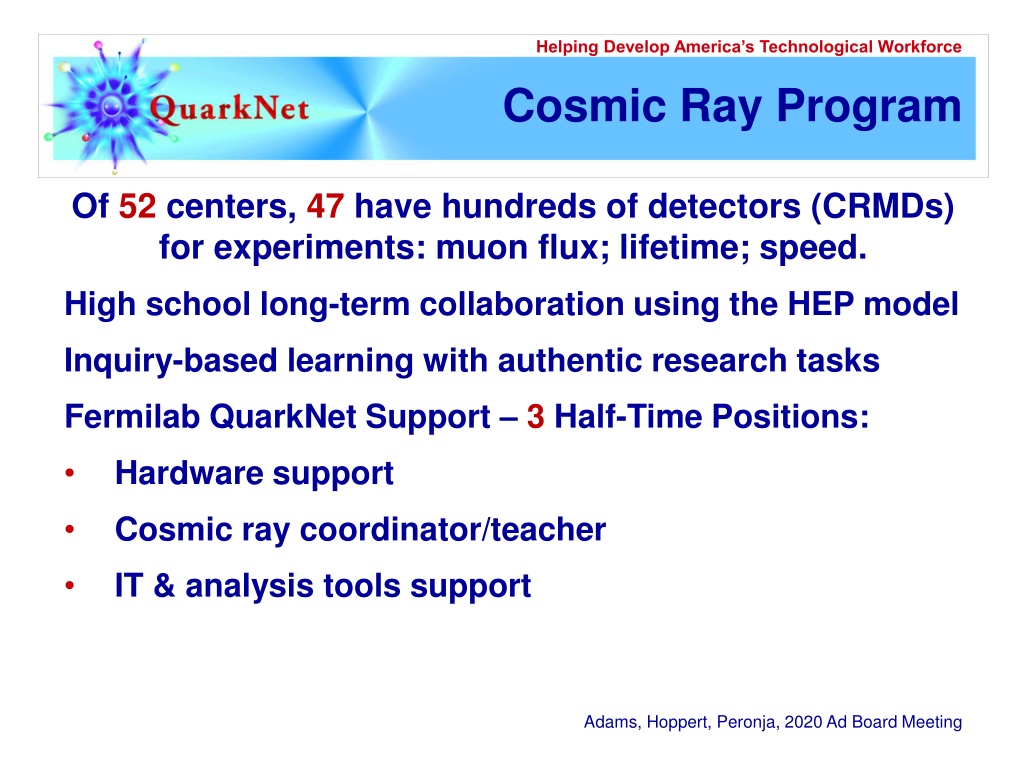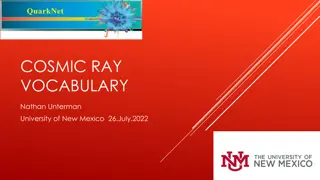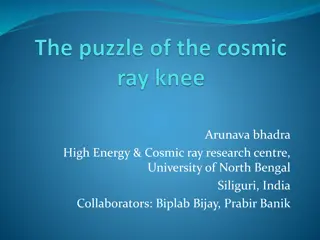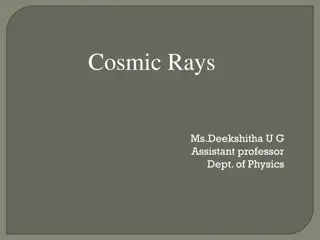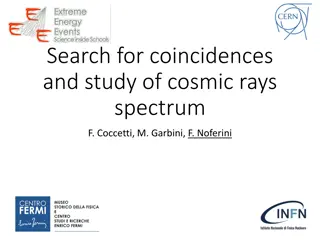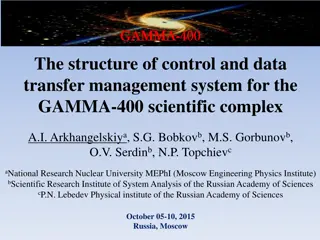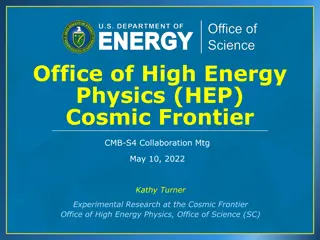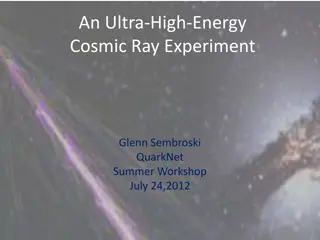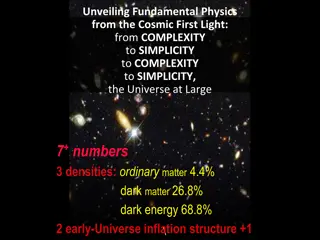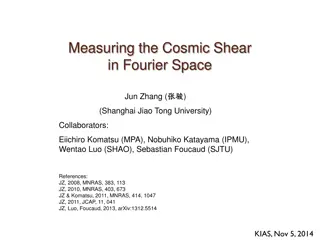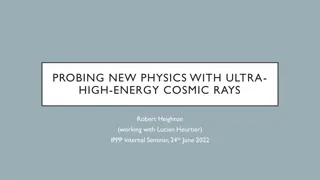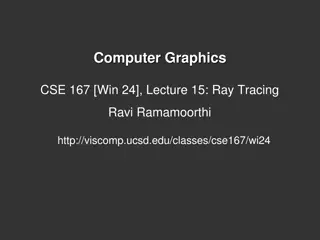Advancing America's Technological Workforce through Cosmic Ray Programs
Engage high school students in cutting-edge cosmic ray experiments, e-Lab analyses, and technology advancements to develop a skilled technological workforce. Foster collaborative learning, research tasks, and data-driven projects to enhance STEM education and prepare students for future innovation. Explore new research ideas, tools, and initiatives while overcoming challenges like hardware failures and limited access due to COVID-19.
Download Presentation

Please find below an Image/Link to download the presentation.
The content on the website is provided AS IS for your information and personal use only. It may not be sold, licensed, or shared on other websites without obtaining consent from the author. Download presentation by click this link. If you encounter any issues during the download, it is possible that the publisher has removed the file from their server.
E N D
Presentation Transcript
Helping Develop Americas Technological Workforce Cosmic Ray Program Of 52 centers, 47 have hundreds of detectors (CRMDs) for experiments: muon flux; lifetime; speed. High school long-term collaboration using the HEP model Inquiry-based learning with authentic research tasks Fermilab QuarkNet Support 3 Half-Time Positions: Hardware support Cosmic ray coordinator/teacher IT & analysis tools support Adams, Hoppert, Peronja, 2020 Ad Board Meeting
Helping Develop Americas Technological Workforce Cosmic Ray e-Lab Analysis Tools Encourage new research ideas with IT maintenance & e-Lab design. Serve high schools without CRMDs (500k logins). Existing data in e-Lab: 106,000 CRMD files (DAQ days) Develop new tools & enhancements that users request/need. Rates for Eclipse Project (>30 U.S. schools joint project) Shower module for cosmic ray air showers Rate versus pressure (CME search & storm tracking) Improve Muon Lifetime user interface (ongoing) Integrate Muon Underground Shielding Experiment (MUSE) data. Adams, Hoppert, Peronja, 2020 Ad Board Meeting
Helping Develop Americas Technological Workforce e-Lab Progress This Year In Addition to COVID Response Monitor data uploads; fix files with incorrect dates. Add absolute time to modified Shower. Repair Lifetime decay selection & fitting. Test Notre Dame Cosmic Watch prototype. Adams, Hoppert, Peronja, 2020 Ad Board Meeting
Helping Develop Americas Technological Workforce Usage Last Two Years Three Eras: Before GPS After GPS COVID 6 April 19: U.S. GPS hardware failure Interrupted uploads; firmware update reprogrammed, mostly by Dave at FNAL (175 units). March 20: COVID-19 Very limited access to CRMDs; teachers in survival mode; don t ask too much. DAQ/Uploads Comparison for 6-Month Periods Apr. Oct.: Apr. Oct. 2018 74 DAQs/2,860 uploads < GPS failure > GPS failure Apr. Oct. 2019 66 DAQs/2,173 uploads COVID Apr. Oct. 2020 27 DAQs/2,733 uploads Conclusions: Most data uploaders remained active after GPS failure. During COVID, fewer but more active users! 2,182 analyses in last month from 23 groups; 26 DAQs (from new tool) Adams, Hoppert, Peronja, 2020 Ad Board Meeting
Helping Develop Americas Technological Workforce Future Projects Expand simple e-Lab analyses to offer customized data taking upon request; serve those without CRMDs; university labs? Inexpensive detector (Cosmic Watch or OSECHI) Establish requirements for classroom use; work with expert users; build & evaluate next prototype; build classroom set. Post-Processing More complex analyses by coding fellows Upward Muon Search; Shower Direction Reconstruction g-2 at home Pyramid Archaeometry at Chichen Itza has NSF provisional approval. QuarkNet will host data: Chicago State U. (Black students) & Dominican U. (Hispanic students); Detector 2024 Solar Eclipse. American Indian Center in Chicago (FNAL project; may offer cosmic ray mentorship.) Adams, Hoppert, Peronja, 2020 Ad Board Meeting
Helping Develop Americas Technological Workforce Fellows & Special Projects Cosmic Ray Fellows & Staff Spawn Exciting Projects. International Muon Week (CU; JHU) Storm Tracking (KSU; UPRM; HI) Solar Eclipse 2017 (UIC plus many around U.S.) MUSE 2019 Cosmic rays in MINOS tunnel (UIC) First proposal to Fermilab from a high school group Link between Cosmics & FNAL s focus on neutrinos g-2 (CU, future) Some results were presented at conferences. Fellows developed virtual workshop; ran one over summer. Adams, Hoppert, Peronja, 2020 Ad Board Meeting
Helping Develop Americas Technological Workforce Cosmic Rays International Global Outreach Activities IPPOG Global Cosmics follows masterclass examples. International Cosmic Day (DESY) in November International Muon Week (QuarkNet-Fermilab) in March (fellows run) Eclipse Project 2017 (30 U.S. high schools plus several non-U.S. locations) Teacher presentations at AAPT & ICRC2019 DAQ Licensing (Goodwill for FNAL) 400 DAQs in 31 countries used for outreach & research Uploads from 92 DAQs in 27 countries Adams, Hoppert, Peronja, 2020 Ad Board Meeting
Helping Develop Americas Technological Workforce COVID COVID Response Created simple experiments using existing data & e-Lab analyses. Collected standard data sets for classroom use; teachers moved CRMDs home. Lecture/Activity on how to perform several e-Lab experiments: muon speed; rates; lifetime New tool to monitor files accessed by users Fellows developed virtual cosmic workshop (1 summer workshop; virtual template customized for 1- to 5-day workshops). Adams, Hoppert, Peronja, 2020 Ad Board Meeting
